AMD Ryzen 9 5980HS Cezanne Review: Ryzen 5000 Mobile Tested
by Dr. Ian Cutress on January 26, 2021 9:00 AM EST- Posted in
- CPUs
- AMD
- Vega
- Ryzen
- Zen 3
- Renoir
- Notebook
- Ryzen 9 5980HS
- Ryzen 5000 Mobile
- Cezanne
Our previous set of ‘office’ benchmarks have often been a mix of science and synthetics, so this time we wanted to keep our office section purely on real world performance.
Agisoft Photoscan 1.3.3: link
The concept of Photoscan is about translating many 2D images into a 3D model - so the more detailed the images, and the more you have, the better the final 3D model in both spatial accuracy and texturing accuracy. The algorithm has four stages, with some parts of the stages being single-threaded and others multi-threaded, along with some cache/memory dependency in there as well. For some of the more variable threaded workload, features such as Speed Shift and XFR will be able to take advantage of CPU stalls or downtime, giving sizeable speedups on newer microarchitectures.
For the update to version 1.3.3, the Agisoft software now supports command line operation. Agisoft provided us with a set of new images for this version of the test, and a python script to run it. We’ve modified the script slightly by changing some quality settings for the sake of the benchmark suite length, as well as adjusting how the final timing data is recorded. The python script dumps the results file in the format of our choosing. For our test we obtain the time for each stage of the benchmark, as well as the overall time.
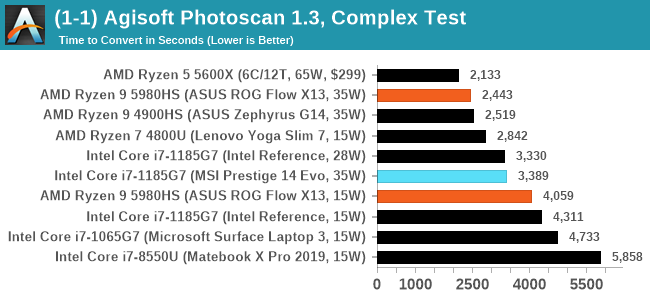
The new Zen 3 system offers a small speed up over the previous generation, and a large lead over the Intel competition here.
Application Opening: GIMP 2.10.18
First up is a test using a monstrous multi-layered xcf file to load GIMP for the first time. While the file is only a single ‘image’, it has so many high-quality layers embedded it was taking north of 15 seconds to open and to gain control on the mid-range notebook I was using at the time. This test is also the run where GIMP optimizes itself, and the optimization requirements scale linearlly with the number of threads in the system.
What we test here is the first run - normally on the first time a user loads the GIMP package from a fresh install, the system has to configure a few dozen files that remain optimized on subsequent opening. For our test we delete those configured optimized files in order to force a ‘fresh load’ each time the software in run. As it turns out, GIMP does optimizations for every CPU thread in the system, which requires that higher thread-count processors take a lot longer to run. So the test runs quick on systems with fewer threads, however fast cores are also needed.
We measure the time taken from calling the software to be opened, and until the software hands itself back over to the OS for user control. The test is repeated for a minimum of ten minutes or at least 15 loops, whichever comes first, with the first three results discarded.
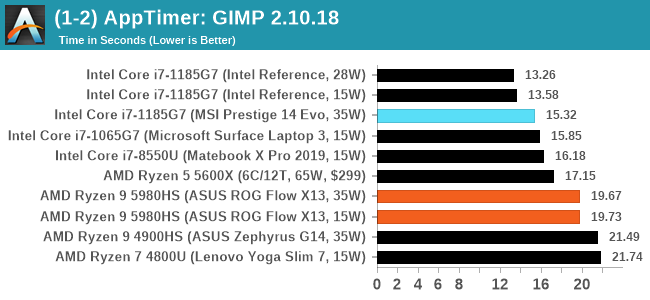
Due to the fast cores and fewer threads, Tiger Lake wins here, but AMD's new processor does offer a good 10% speed up generation over generation.
RISCV Toolchain Compile
Our latest test in our suite is the RISCV Toolchain compile from the Github source. This set of tools enables users to build software for a RISCV platform, however the tools themselves have to be built. For our test, we're running a complete fresh build of the toolchain, including from-stratch linking. This makes the test not a straightforward test of an updated compile on its own, but does form the basis of an ab initio analysis of system performance given its range of single-thread and multi-threaded workload sections. More details can be found here.

This is a new test, so we are still filling in data points with systems we still have at hand.
Science
In this version of our test suite, all the science focused tests that aren’t ‘simulation’ work are now in our science section. This includes Brownian Motion, calculating digits of Pi, molecular dynamics, and for the first time, we’re trialing an artificial intelligence benchmark, both inference and training, that works under Windows using python and TensorFlow. Where possible these benchmarks have been optimized with the latest in vector instructions, except for the AI test – we were told that while it uses Intel’s Math Kernel Libraries, they’re optimized more for Linux than for Windows, and so it gives an interesting result when unoptimized software is used.
3D Particle Movement v2.1: Non-AVX and AVX2/AVX512
This is the latest version of this benchmark designed to simulate semi-optimized scientific algorithms taken directly from my doctorate thesis. This involves randomly moving particles in a 3D space using a set of algorithms that define random movement. Version 2.1 improves over 2.0 by passing the main particle structs by reference rather than by value, and decreasing the amount of double->float->double recasts the compiler was adding in.
The initial version of v2.1 is a custom C++ binary of my own code, and flags are in place to allow for multiple loops of the code with a custom benchmark length. By default this version runs six times and outputs the average score to the console, which we capture with a redirection operator that writes to file.
For v2.1, we also have a fully optimized AVX2/AVX512 version, which uses intrinsics to get the best performance out of the software. This was done by a former Intel AVX-512 engineer who now works elsewhere. According to Jim Keller, there are only a couple dozen or so people who understand how to extract the best performance out of a CPU, and this guy is one of them. To keep things honest, AMD also has a copy of the code, but has not proposed any changes.
The 3DPM test is set to output millions of movements per second, rather than time to complete a fixed number of movements.
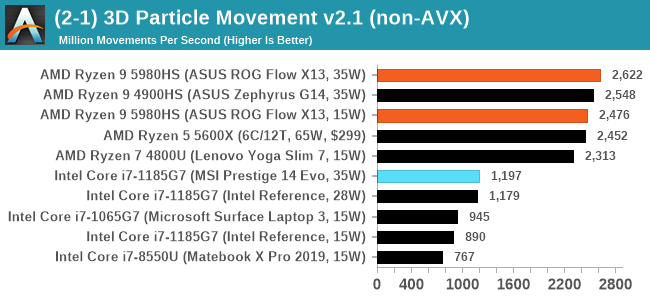
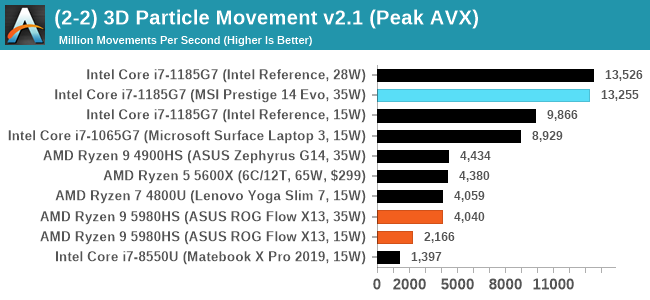
Intel's Tiger Lake has AVX-512 units, which is why they are so far ahead in the peak AVX test. For AMD vs AMD, we're seeing around the same score between the previous generation Zephyrus and the new Flow X13, however in multithreaded the Flow X13 seems to regress slightly.
y-Cruncher 0.78.9506: www.numberworld.org/y-cruncher
If you ask anyone what sort of computer holds the world record for calculating the most digits of pi, I can guarantee that a good portion of those answers might point to some colossus super computer built into a mountain by a super-villain. Fortunately nothing could be further from the truth – the computer with the record is a quad socket Ivy Bridge server with 300 TB of storage. The software that was run to get that was y-cruncher.
Built by Alex Yee over the last part of a decade and some more, y-Cruncher is the software of choice for calculating billions and trillions of digits of the most popular mathematical constants. The software has held the world record for Pi since August 2010, and has broken the record a total of 7 times since. It also holds records for e, the Golden Ratio, and others. According to Alex, the program runs around 500,000 lines of code, and he has multiple binaries each optimized for different families of processors, such as Zen, Ice Lake, Sky Lake, all the way back to Nehalem, using the latest SSE/AVX2/AVX512 instructions where they fit in, and then further optimized for how each core is built.
For our purposes, we’re calculating Pi, as it is more compute bound than memory bound. In single thread mode we calculate 250 million digits, while in multithreaded mode we go for 2.5 billion digits. That 2.5 billion digit value requires ~12 GB of DRAM, and so is limited to systems with at least 16 GB.

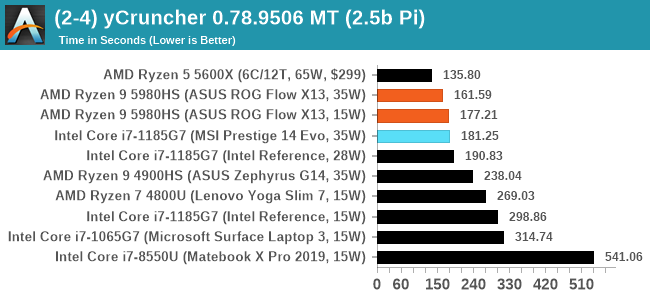
Intel here again benefits from AVX-512, however for a big multithreaded test, the eight cores of AMD pushes it ahead. Compared to the previous generation AMD processor, we see significant speedups for both ST and MT, showcasing the benefits of the new Zen 3 core and cache system.
NAMD 2.13 (ApoA1): Molecular Dynamics
One of the popular science fields is modeling the dynamics of proteins. By looking at how the energy of active sites within a large protein structure over time, scientists behind the research can calculate required activation energies for potential interactions. This becomes very important in drug discovery. Molecular dynamics also plays a large role in protein folding, and in understanding what happens when proteins misfold, and what can be done to prevent it. Two of the most popular molecular dynamics packages in use today are NAMD and GROMACS.
NAMD, or Nanoscale Molecular Dynamics, has already been used in extensive Coronavirus research on the Frontier supercomputer. Typical simulations using the package are measured in how many nanoseconds per day can be calculated with the given hardware, and the ApoA1 protein (92,224 atoms) has been the standard model for molecular dynamics simulation.
Luckily the compute can home in on a typical ‘nanoseconds-per-day’ rate after only 60 seconds of simulation, however we stretch that out to 10 minutes to take a more sustained value, as by that time most turbo limits should be surpassed. The simulation itself works with 2 femtosecond timesteps. We use version 2.13 as this was the recommended version at the time of integrating this benchmark into our suite. The latest nightly builds we’re aware have started to enable support for AVX-512, however due to consistency in our benchmark suite, we are retaining with 2.13. Other software that we test with has AVX-512 acceleration.
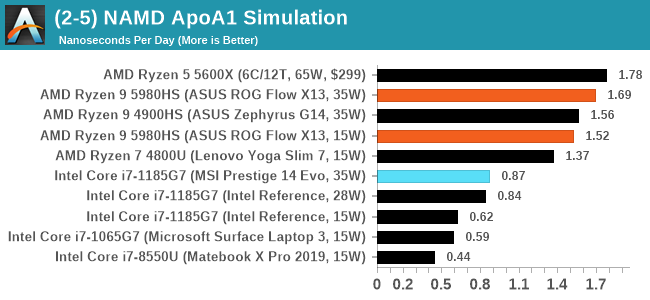
NAMD also sees good speedups, and the eight core mobile processor is within reach of that six-core desktop processor. Intel lags behind on the 2.13 version, as we wait for the AVX-512 to come out of alpha versions of the software.
AI Benchmark 0.1.2 using TensorFlow: Link
Finding an appropriate artificial intelligence benchmark for Windows has been a holy grail of mine for quite a while. The problem is that AI is such a fast moving, fast paced word that whatever I compute this quarter will no longer be relevant in the next, and one of the key metrics in this benchmarking suite is being able to keep data over a long period of time. We’ve had AI benchmarks on smartphones for a while, given that smartphones are a better target for AI workloads, but it also makes some sense that everything on PC is geared towards Linux as well.
Thankfully however, the good folks over at ETH Zurich in Switzerland have converted their smartphone AI benchmark into something that’s useable in Windows. It uses TensorFlow, and for our benchmark purposes we’ve locked our testing down to TensorFlow 2.10, AI Benchmark 0.1.2, while using Python 3.7.6.
The benchmark runs through 19 different networks including MobileNet-V2, ResNet-V2, VGG-19 Super-Res, NVIDIA-SPADE, PSPNet, DeepLab, Pixel-RNN, and GNMT-Translation. All the tests probe both the inference and the training at various input sizes and batch sizes, except the translation that only does inference. It measures the time taken to do a given amount of work, and spits out a value at the end.
There is one big caveat for all of this, however. Speaking with the folks over at ETH, they use Intel’s Math Kernel Libraries (MKL) for Windows, and they’re seeing some incredible drawbacks. I was told that MKL for Windows doesn’t play well with multiple threads, and as a result any Windows results are going to perform a lot worse than Linux results. On top of that, after a given number of threads (~16), MKL kind of gives up and performance drops of quite substantially.
So why test it at all? Firstly, because we need an AI benchmark, and a bad one is still better than not having one at all. Secondly, if MKL on Windows is the problem, then by publicizing the test, it might just put a boot somewhere for MKL to get fixed. To that end, we’ll stay with the benchmark as long as it remains feasible.
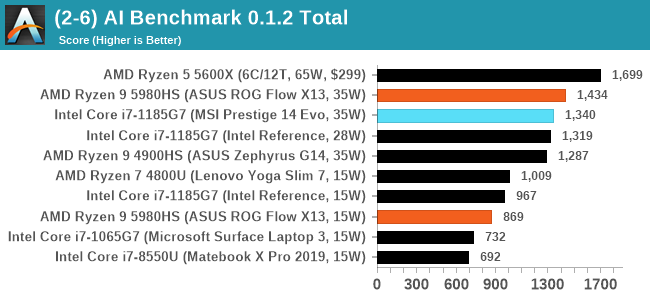
There's a good jump for AMD here generation-on-generation, pushing it ahead of Tiger Lake. At 15 W however, Intel would seem to have the upper hand.




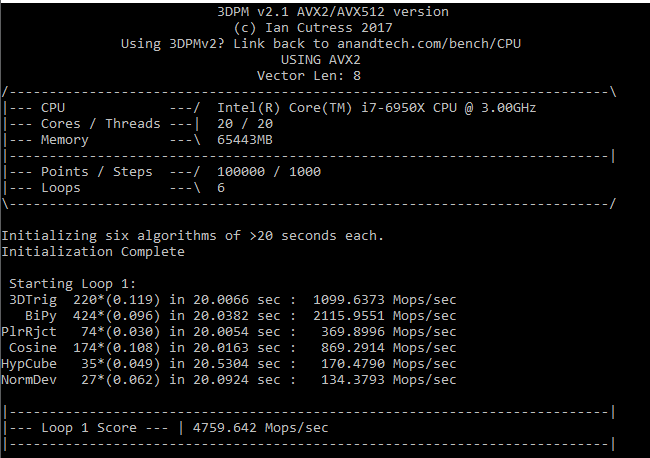

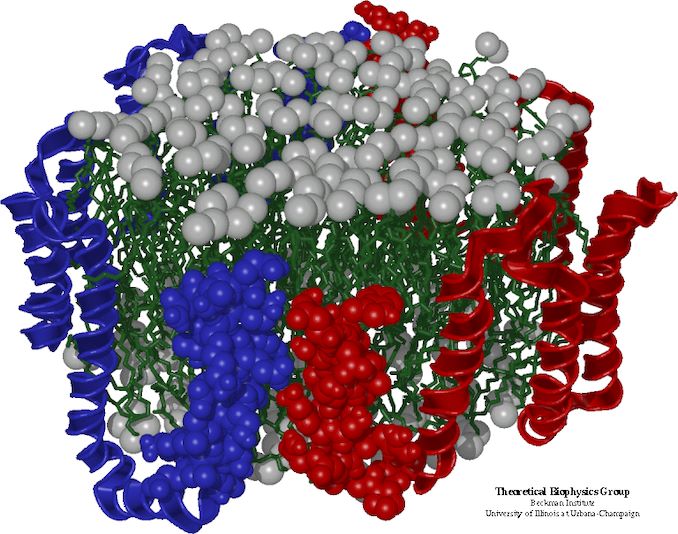









218 Comments
View All Comments
Meteor2 - Thursday, February 4, 2021 - link
Great point.ikjadoon - Tuesday, January 26, 2021 - link
It's great to see AMD kicking Intel's butt in a much larger market (i.e., laptops vastly outsell desktops): AMD really should be alongside, or simply replacing, Intel in most premium notebooks. Gaming notebooks are not my cup of tea, but glad to see for upcoming 15W Zen3 parts.Will we see actual, high-end Zen3 notebooks? Lenovo, HP, ASUS, Dell: for shame if you keep ramming toasty Tiger Lake down customers' throats. Lenovo's done some great offerings with both AMD & Intel; that means some compromises with notebook design (just go all AMD, man; if/when Intel is on top, switch back!), but beefier cooling for Intel will also help AMD.
Still, overall, I don't see anything convincing me that x86 is really right for notebooks, either. So much waste heat...for what? The M1 has rightly rejiggered expectations: 20 hours on 150 nits should be ordinary, not miraculous. Limited to no fan spin-up and max CPU load should yield a chassis maximum of 40C (slightly warmer than body temperature). And, all the while with class-leading 1T performance.
As this is a gaming laptop, it's not too relevant to compare web benchmarks (what most laptops do), but this is peak Zen3 mobile and it still falls quite short:
Speedometer 2.0
35W Ryzen 5980HS: 102 points (-57%)
125W i9-10900K: 119 points (-49%)
35W i7-1185G7: 128 points (-46%)
105W Ryzen 5950X: 140 points (-40%)
30W Apple M1: 234 points
You can double / triple x86 wattage and still be miles behind M1. I almost feel silly buying an x86 laptop again: just kilowatts of waste heat over time. Why? Electrons that never get used, just exhausted and thrown out as soon as possible because it'll throttle even worse otherwise.
undervolted_dc - Tuesday, January 26, 2021 - link
because you here are benchmarking javascript engine in the browserbut not being enough you are comparing those in single thread so here you are comparing 1/16 of the 5950hs vs 1/4 of the m1
a 128core epyc or a 64core threadripper probably will be even worse in this single threaded benchmark ( because those are levaring threads and are less efficient in single threaded app )
if you like wrong calculations then 1 core of the 15w version use less tha 1w for what result ? ~ 100 points ? so who is wasting electrons here ?
( btw 1 core doesn't use 1/16 because there are boosts , but it's even less wrong than your comparison )
ZoZo - Tuesday, January 26, 2021 - link
128-core EPYC? Where?His comparison is indeed misleading in terms of energy efficiency, but it's sad that no x86 is able to come even close to that single-threaded performance.
WaltC - Tuesday, January 26, 2021 - link
Doubly sad for the M1 that we are living in the multicore/multithread era...;)ikjadoon - Tuesday, January 26, 2021 - link
The energy efficient comparisons are pretty clear: the best x86 (Zen3) has stunningly lower IPC than M1, which barely cracks 3 GHz. The only way to make up for such a gulf in IPC is faster clocks. Faster clocks require the 100+W TDPs so common in high-performance desktop CPUs. It's why Zen3 mobile clocks so much lower than Zen3 desktop (3-4 GHz instead of 4-5 GHz)A CPU that needs 3x power to do the same work (and do it slower in most cases) must exhaust an enormous amount of heat, when considering nT or 1T benchmarks (Zen3 requires ~20W for 5 GHz boost on a *single* core). Look at those boost power consumption measurements.
Specifically in desktops (noted in my comparison about tripling TDP...), the CPU *alone* eats up an extra 60 to 90 watts during peak usage. Call it +20W average continuously, so we can do the math.
20W x 8 hours x 7 days a week = +1.1 kWh excess exhaust heat per week. x86 had two corporate giants to do better. It's been severely litigated, but that's Intel's comeuppance. If Intel can't put out high-perf, high-efficiency x86 architectures, then people will start to feel less attached to x86 as an ISA. x86 had billions and billions and billions of R&D.
I see no reason for consumers to religiously follow x86 Wintel or Wintel-clones in laptops especially, but desktops, too: where is the efficiency going to be coming from? Even if Apple *had flat 1T* for the next three years, I'd still feel more optimistic about M1-based CPUs in the long-term than x86.
Dug - Tuesday, January 26, 2021 - link
"I see no reason for consumers to religiously follow x86 Wintel or Wintel-clones in laptops especially, but desktops, too: where is the efficiency going to be coming from?"Software, and getting work done. M1 is great and all, but just need to convince the boss that Apple or 3rd party has software available for our company....... Nope, oh well.
Other negatives-
For personal use, people aren't going to spend thousands of dollars to get new software on new platform.
They can't play games (or should I say they can't play a majority), which is probably the largest market.
They can't change anything about their software
They can't customize anything.
They can't upgrade any piece of their hardware.
They don't have options for same accessories.
So I'll go ahead and spend the extra $15 a year on energy to keep Windows.
Spunjji - Thursday, January 28, 2021 - link
"A CPU that needs 3x power to do the same work"It doesn't. It's been demonstrated a few times now that if you scale back Zen 3 cores to similar performance levels to M1, M1's perf/watt advantage drops to about 30%. It's still better than the node advantage alone, but it's not crippling, and M1 is simply not capable of scaling up to the clock speeds required to match x86 on desktop / HPC workloads.
They're different core designs matched to different purposes (ultra-mobile first vs. server first) and show different strengths as a result.
M1 is a significant achievement - no doubt about it - but you're *massively* overstating the case in its favour.
GeoffreyA - Friday, January 29, 2021 - link
Thank you for this.Meteor2 - Thursday, February 4, 2021 - link
"M1 is simply not capable of scaling up to the clock speeds required to match x86 on desktop / HPC workloads" ...Yet. In a couple of years x86 will be behind ARM across the board.Fastest HPC in the world is ARM *right now*. Only the fifth fastest is x86.